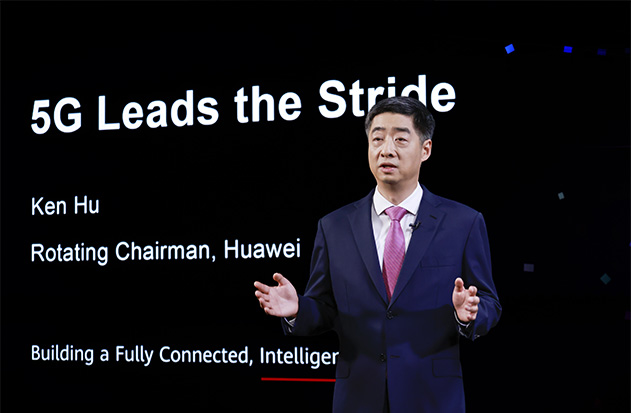
5G leads the stride
-- At Huawei's Global Mobile Broadband Forum (MBBF) 2022 held in Bangkok on October 25th, the company's Rotating Chairman, Ken Hu, delivered a keynote titled "5G Leads the Stride". During the keynote, Hu noted that "5G has grown faster than any previous generation of mobile technology, but more can be done to fully unleash its value."

As the global economy slowly recovers, many industries are seeking growth through digital transformation. 5G has created unprecedented opportunities by enabling new use cases, applications, and models in all industries.
From deployment to rapid development
5G has grown faster than any previous generation of mobile technology. In just three years, there are now over 200 5G networks and more than 700 million 5G users around the world.
This rapid development is driving new shifts in consumer behavior. For example: High-definition video now accounts for 60% of all 5G traffic. And new mobile applications like short videos, livestreaming, and cloud phone are driving growth in DOU, ARPU, and revenue.
Even more exciting is the progress on the B2B side. We're seeing many brand new 5G-powered applications in industries like oil and gas, mining, manufacturing, and transportation. For example, applications like autonomous mining trucks were not practical without 5G.
These applications are not only innovative – they're generating real commercial value for carriers too. In China, for example, the numbers are adding up fast. In 2021, Chinese carriers brought in almost $500 million dollars from 5GtoB projects. That's from connectivity alone. The exciting part is, 5GtoB projects have also generated 10 times that amount from new revenue sources, like data and integrated ICT services.
I'm confident that this momentum will continue, and 5GtoB services will become a powerful new growth engine for our industry.
New growth opportunities for carriers
Starting back in 2012, after 10 years of R&D, investment, and pilots, 5G is finally in the fast lane. We should all be proud of the progress that we've made.
But this is only the beginning. There's more we can do to fully unleash the value of 5G. In the consumer market, more than a billion new 5G devices have shipped. Some carriers have achieved a 5G traffic ratio greater than 50%, but for many carriers, it’s still lower than 20%. There's a lot of room to push these numbers up.
At the same time, carriers can explore new experience-based revenue models, such as premium packages that guarantee speed and latency. From my observations, these are already becoming popular in Europe and South Korea. And they are growing fast.
As for the 2B market, 5G is a key enabler for digital transformation. 5G's wide coverage and fast speeds are perfect for scenarios like smart grids and smart transportation.
In other domains like mining and manufacturing, companies can leverage 5G's reliability and fast uplink for scenarios like video inspection and remote controls.
By unleashing the full capabilities of 5G, we can help industries go digital and unlock new growth for carriers.
Building out networks for better user experience
To seize these opportunities, there are a few things we need to do. First, we need to keep building out networks and improving user experience.
Right now, 5G only covers 30% of the global population. That's still a big gap with 4G.
In addition to coverage, we need to optimize networks for different types of user experience. For example: Chinese carriers have optimized their 5G networks for TikTok and other popular video services. They have greatly reduced latency and lag for a much smoother video experience. As we all know, 3G, 4G, 5G – most consumers don’t have a clear concept of what these mean.
But the difference in experience is very clear. You can feel it. And better experience is a great way to attract new users to 5G services.
To keep pushing experience to the next level, we also need to push network capabilities to the next level. 5.5G is the path forward.
Together with carriers and industry partners, we've proposed four features for 5.5G networks: 10 Gbps downlink, 1 Gbps uplink, support for 100 billion connections, and native intelligence. To achieve this, the industry needs to come together – define standards, prepare the spectrum, and build out the ecosystem.
Drive service innovation to maximize the value of 5G
Better networks will help us to innovate more on services. For consumers, we can provide a brand new experience with services like extended reality and cloud gaming.
For example, three carriers in China are working on enriched 5G calling services, which include smart conferences, real-time translation, and remote guidance.
These services will provide users with a brand new experience for 5G calls, like multimedia, visualization, and more personal interaction.
For businesses, carriers can go beyond connectivity and provide more comprehensive digital transformation solutions. In the past two years, we have seen many great cases in different markets around the world. Let me share with you some examples.
In Thailand, carriers are working with partners to help a smart hospital in Bangkok provide new services like 5G smart ambulances and remote consultation.
In South Africa, a carrier has helped a mining company find partners to deploy applications on its 5G network. With these applications, the mine has automated many aspects of operations and maintenance.
Not only do these applications provide practical value for industries, moving forward, carriers can also leverage 5G with cloud and AI, to expand into integration services and open up new revenue streams.
Of course, this requires new capabilities, including cloud, system integration, and also consulting and planning for digital transformation.
These all require a different set of core competencies, and Huawei is more than happy to work with carriers to bridge any capability gaps.
5G is developing fast, and there's so much potential out there. But we still have a lot of challenges ahead of us. I’m confident that if we work together, we can make great strides together.


